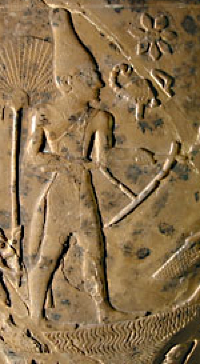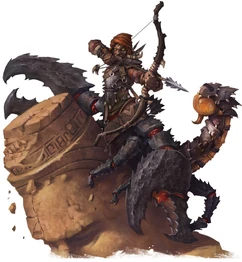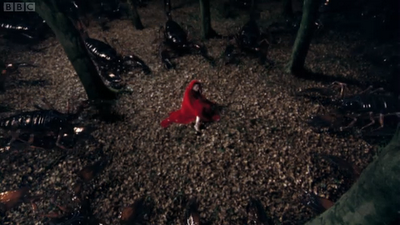[3][4], The scorpion fetish, which underlies the name of Scorpion II, is generally linked to the later-introduced goddess Selket, but Egyptologists and linguists such as L.D.
The reign of Scorpion II (circa 3100 BC) seems to be linked to an outstanding and more advanced civilization from Mesopotamia. The traces strengthen the presumption that the scene on the Scorpion macehead once contained the depiction of a second figure of the king, wearing the Red Crown of Lower Egypt. Others, such as Gnter Dreyer and Wolfgang Helck, are not so sure and read it as a sloppily drawn version of the name of King Ka.
Thus, the golden rosette became an official emblem of Seshat.
[10][11], Behind the king (on the left side) two fan bearers follow the king.
Carbon-14 dating showed that the scepter dates from about 3250 BC, making it the oldest scepter found in Egypt. And he had 700 jars of wine, about 4500 liters.
Great achievements for a man who for nearly 5,000 years was thought to be mythical. The exact burial place of Scorpion II is unknown. Several ivory tags with scorpion figures were found here. I am the scientific director of the Biomolecular Archaeology Project. Dynasty Zero.
He holds a hoe, which has been interpreted as a ritual either involving the pharaoh ceremonially cutting the first furrow in the fields, or opening the dikes to flood them. Dreyers most controversial find in the tomb was a series of 160 bone and ivory tags the size of postage stamps carved with simple pictures that Dreyer believes are primitive hieroglyphs. This totally refutes the accepted theory of the origin of writing, Dreyer said. The Egyptian cosmology, cosmogony, governmental hierarchy and administration, writing, dress, its concept of kingshipthese were all things most definitely Egyptian, even if perhaps influenced by outside contacts. The Gebel Tjauti tableau in the Theban Desert, possibly a record of a military expedition from about 3200 BC. They appear on the Two-dogs-palette and on several ivory artifacts.
One unique tag shows the scorpion holding a long stick, smiting an enemy. You know its sort of like today when we want to show off to our friends.
Archeologists Discover Ancient Burial Site of Infants, Scorpions and Crocodiles, http://www.touregypt.net/featurestories/hdyn00.htm. Both tombs had small ivory tags with scorpions etched onto them. In the English-speaking world today, vampires are perhaps most famously associated with the region of Transylvania in Romania, thanks to Bram Stokers Gothic horror novel, Dracula . However, all other details of Bastet cult worship during this period have been lost. The Scorpion King 3: Battle for Redemption, Muslim conquest of Mesopotamia and Persia, https://en.wikipedia.org/w/index.php?title=Scorpion_II&oldid=1095881749, Short description is different from Wikidata, Wikipedia indefinitely semi-protected pages, Wikipedia articles needing clarification from March 2016, Pages using multiple image with auto scaled images, Creative Commons Attribution-ShareAlike License 3.0, The Scorpion King's name was used in the 2001 film, This page was last edited on 1 July 2022, at 00:05. Most linguists and Egyptologists read it Neb (for 'lord') or Nesw (for 'king'), and they are convinced that the golden rosette was some kind of forerunner to the later serekh. Scholars point to the fact that creatures such as the chimera and the serpopards were of Mesopotamian origin.
The second way to experience Egypt is from the comfort of your own home: online. Even in these early times, the heqa scepter was a powerful tool of the king, and remained so until the Roman times.
In: Gnter Dreyer: "Horus Krokodil: Ein Gegenknig der Dynastie 0". Candidate at the Faculty of Languages, University of Gdansk. Before Dynasty One began with the unification of Egypt, there was a Dynasty Zero that began with the unification of the south, Darnell said. All Rights Reserved. Egypts culture is a product of its geography, its people, and at least to some degree by its links with its neighbors. [10], Numerous small ivory tags showing the depiction of a scorpion were found. And he was buried with all the things you might expect. Although the tomb had been pillaged and the mummy stolen, Dreyer found an ivory scepter, a clear indication that it was a royal tomb.
In short, King Scorpion was one of the fathers of Egyptian civilization. It has been dated to the Late Predynastic - Early Dynastic period.
The second one is located at Hierakonpolis and is registered as Tomb HK6-1. Many of the tags, Dreyer says, are documentary records of linen and oil delivered to King Scorpion, short notes, numbers, lists of kings names and names of institutions. Tour Egypt aims to offer the ultimate Egyptian adventure and intimate knowledge about the country. We cannot establish family lines during this period, and the term "Dynasty 0" attempts to take in rulers in different locations ruling different territories.
The architectural methods used for building complex and stable tombs were clearly copied from Mesopotamian buildings.
So he had jars of beer, the clothes that he would need in the afterlife, but also wine.  The mace--the oldest ever found in Egypt--portrays a man wearing the white crown of Upper Egypt, accompanied by the symbols for king and scorpion. This emblem can be found on numerous objects from the Dynasty 0 and Dynasty I periods; it vanishes until the end of the Third Dynasty, when it re-appears under high-ranked officials, such as Khabawsokar and A'a-akhty (both dated to the end of the Third Dynasty). Five days passed before his body was found.
The mace--the oldest ever found in Egypt--portrays a man wearing the white crown of Upper Egypt, accompanied by the symbols for king and scorpion. This emblem can be found on numerous objects from the Dynasty 0 and Dynasty I periods; it vanishes until the end of the Third Dynasty, when it re-appears under high-ranked officials, such as Khabawsokar and A'a-akhty (both dated to the end of the Third Dynasty). Five days passed before his body was found.
This surely was a further important step toward Egypt's future as a powerful and wealthy kingdom.
Egyptian traveled to and traded with Palestine, where pottery and Egyptian-style buildings have been found, with Afghanistan and beyond to modern Pakistan, the source for lapis lazuli, documented to have been imported into Egypt from Predynastic time.
In later dynasties, this motif became a hieroglyph, registered as Gardiner A38 and Gardiner A39. Quibell in 1897-98. [24], Second Intermediate PeriodSixteenthDynasty
In hieroglyphics these rekhyts have been interpreted to represent the common people of Egypt, and their fate seems to indicate that they were conquered by King Scorpion.
His name is often introduced by a six- or seven-leafed, golden rosette or flower-sign. ( GFDL).
Scorpion was a king in southern Egypt that was buried in a very spectacular way. They have royal serekhs incarved at their bellies and the reading of the name inside is disputed.
I am sure you are familiar with his legend which states that he was born in a manger surrounded by shepherds, Atacama Giant and Cusco Temple linked to Stone Age astronomical writing, Englands Oldest Known Shipwreck Found, With A Morbid Cargo, Eight Surprising Things You Should Know About the Celts, 7.2 million-Year-Old Pre-Human Fossil Suggests Mankind Arose in Europe NOT Africa, Queen Christina of Sweden Kept an Itty-Bitty Flea Cannon by Her Bed, Top Ten Giant Discoveries in North America.
The festive parade looks into the opposite direction of the king and his standard bearers; an outstretched complete view reveals that both processions meet each other in the center of the whole macehead relief scene.
Tutankahmun, Cleopatra's Palace at Alexandria--we know of these things--we race to visit them, to see and touch and learn, because of what the Egyptologists have accomplished. There were two Scorpion Kings in the pre-dynastic period of ancient Egypt. Thus the Scorpion macehead and Narmer palette may represent the respective rulers as having successfully defeated foreigners from the west Delta (something which happened later in history as well. Without new research, it is impossible to know whether his tomb is either of the two suggested locations or if it even still exists.
Two serekhs written on pottery vessels from Tarkhan have been read as Scorpion, but that is not yet considered a conclusive reading either.
Conquering and warfare had to be economically promoted, warriors and guardians had to be fed. Who is this King that may soon be as familiar as his later, more historically documented successors such as Hatshepsut, Tutankhamun, and Cleopatra VII? [10][11][18][20][21], Hierakonpolis revetment of Temple basement.
[9], The Scorpion Macehead depicts a single, large figure wearing the White Crown of Upper Egypt. And we did the analysis of this and were able to show that it included lots of Levantine spices, like savory, thyme, coriander. It might also be referring to another comet strike. [10][11][18][20][21], The "winged chimeras" were named Sefer in Egyptian and they represent chaos and violence. Researchers found enough evidence to confirm trade and political contacts among these two kingdoms.
Pharaoh Scorpion II is depicted on the Scorpion Macehead. They also argue that the artistic style seen on the macehead of Scorpion II shows conspicuous similarities to that on the famous Narmer macehead. She Read More. Some scholars believe that Narmer and Menes were the same person.
But, since it seems clear that Egypt was divided into at least two coexisting kingdoms, scholars wonder on which kind of power factor the rulership of protodynastic kings was based.
So he had jars of beer, the clothes that he would need in the afterlife, but also wine. Some other tags show the scorpion close over a swallow sign, which reads 'the scorpion is great'. On the Narmer palette, two serpopards are entwining their necks. Perhaps Narmer was the first king who actually reigned unchallenged throughout the country. He holds one lion in each hand, both at his sides. Indeed, most of the artworks dicussed have better and more consistent intepretations in terms of zodiacal dating. Norimitsu Odachi: Who Could Have Possibly Wielded This Enormous 15th Century Japanese Sword?
King Scorpion's name and title are of great dispute in modern Egyptology.
However, with all the similarities that can be noted, there are also significant differences between Near Eastern cultures and that which is undeniably Egyptian. Several ivory tags with scorpion figures were found here.
Top Image: The second ancient Egyptian Scorpion King. But it is unknown where these gods had their cultic centers and shrines, because the hieroglyphs depicting the place names were not introduced yet. On this macehead, Scorpion is apparently performing a ceremony using a hoe.
An example of the existence of the first Scorpion King in Egypt comes from a rock panel found at Gebel Tjauti (to the south-east of Abydos). But in 1898, excavations at Hierakonpolis in Upper Egypt revealed sacred objects dating back to the very beginnings of Egyptian civilization. Did Joseph of Arimathea Bring the Holy Grail to Britain?
We are not sure how it is pronounced yet, but that symbol represents the name of Naqadas king, Darnell said.
Coronavirus cases are soaring in L.A. County, but this wave is different, The SoCal housing market is cooling.
Conquest of Naqada gave King Scorpion control not only of the Nile, but of crucial roads leading east to the Red Sea and west to the oases of the western desert. His name may very well have been Scorpion, though in Egyptian it may have been pronounced something like Srqt. Maybe Scorpion II was the founder of Nekhen or Buto, which would explain why the macehead was found in Hierakonpolis.
However, due to the very few traces left by the people whose lifetime took place during the reign of King Scorpion, it appears that the lands that belonged to his kingdom flourished. Hoofprints of the Devil Spotted in the Snow? Nevertheless, the term "Dynasty 0" has come into general use and is unlikely to be discarded.''.
Indeed, it has been proposed that these inscriptions be attributed to a King called "Crocodile", perhaps a king reigning concurrently with the main Thinite royal family. The fact that Scorpion has suddenly leapt into the most popular Hollywood media is perhaps a victory for the science of Egyptology. You want to focus on the Scorpion King, one of the first kings of Egypt. Grimal, Nicolas, A Hisory of Ancient Egypt, 1988.
This is an artifact that was likely used for ritual purposes (due to the size and decoration on it) and was found at Hierakonpolis. It has also been suggested that King Scorpion was successful in unifying Upper Egypt and set the stage for Narmers unification of Upper and Lower Egypt. Now, the discoveries about King Scorpion are giving us a handle on what really did happen, he said.

And he had 700 jars of wine, about 4500 liters.
For the first time, the inscriptions give the hieroglyphic writings for 'Lower Egypt' and/or 'Upper Egypt'. Twenty-fourth Dynasty of EgyptTefnakht Bakenranef, (Sargonid dynasty)Tiglath-Pileser Shalmaneser Marduk-apla-iddina II Sargon Sennacherib Marduk-zakir-shumi II Marduk-apla-iddina II Bel-ibni Ashur-nadin-shumi Nergal-ushezib Mushezib-Marduk Esarhaddon Ashurbanipal Ashur-etil-ilani Sinsharishkun Sin-shumu-lishir Ashur-uballit II, Seleucid Empire: Seleucus I Antiochus I Antiochus II Seleucus II Seleucus III Antiochus III Seleucus IV Antiochus IV Antiochus V Demetrius I Alexander III Demetrius II Antiochus VI Dionysus Diodotus Tryphon Antiochus VII Sidetes, This article is about Scorpion II. Narmer: First King of Upper and Lower Egypt, a Reconsideration of His Palette and Macehead, Abstract by Frank Yurco, published in JSSEA #XXV. Before research related to the pre-dynastic period started to expand and thrive, the kings who ruled prior to the famous pre-dynastic King Narmer had been completely ignored. The stork represents Horus, the patron god of Abydos, while the snake is Set, the patron god of Naqada. The Vulture Stone of Gobekli Tepe: The Worlds First Pictogram?
Maceheads were early considered to be symbolic of Kingly power, and throughout Egypts history, were shown in relief carvings as the weapon of the king as he smote his enemies who were the enemies of Egypt. Scorpion II (Ancient Egyptian: possibly Selk or Weha[1]), also known as King Scorpion, was a ruler during the Protodynastic Period of Upper Egypt (c. 32003000BCE).
Before Dynasty One,There Was Dynasty Zero. Their death is demonstrated by depicting them standing upside-down and being hit by arrows; two further figures are still holding their own bows and shooting.
And people will travel to Egypt to see where he may have walked, just as they do now to see where Hatshepsut walked.
Based upon Scorpions apparent connection with Hierakonpolis and from the stylistic similarities between his macehead and the palette and macehead attributed to Narmer, the two rulers may well have been close contemporaries. Hierakonpolis ivory cylinder with kneeling men, with impression (drawing).
Patrick McGovern, the author of "Ancient Brews: Rediscovered and Re-Created," reveals what he found when he entered the king's tomb. [ambiguous] Since it is unclear what actual meaning was reserved for the serekh animal of Scorpion II, scholars usually refer to him
:origin()/pre05/b1c9/th/pre/f/2012/076/6/9/cc__dastan_and_tamina_by_mistytang-d4t28jo.jpg)

They come from Abydos, Minshat Abu Omar and Tarkhan. While the character depicted in the movie bears little resemblance to either of the actual pharaohs, the history of the real ancient Egyptian Scorpion Kings is even more thrilling and filled with mystery than the fictional portrayal. Serekhs were the enclosing devices within which the early names of Kings were written. It seems that he was a warrior as well as a skilled politician.
Which was not produced in Egypt, because they did not have the grapevine. as 'King Scorpion II'. Which was not produced in Egypt, because they did not have the grapevine.
His name is depicted by a golden flower-like sign.
So much of history, indeed prehistoric sciences in general, seem to be based on assumption and imagination given the lack of substantive evidence.
The scorpion faces a human figure with an artificial beard and ceremonial knife in a belt; the figure holds a long cord, to which captured Nubians are tied. His burial place also contained some of the earliest evidence for ancient wine the chamber contained dozens of jars with wine residue, as well as grape seeds, skins, and dried pulp. If they are, in fact, writing, they predate the commonly accepted origin of cuneiform writing in Mesopotamia by 200 years.
Ciaowitz, Wilkinson, Butzer and Hoffman see the power source of the protodynastic kings in these agricultural developments. Wilkinson, Toby Alexander Howard, Early Dynastic Egypt, 2001.
Perhaps This and Hierakonpolis each were the centers of rival chiefdoms, and when Scorpions reign ended, This assumed an uncontested position as sovereign of Egypt.
Natalia does research in Narratology, Historiography, History of Galicia (Spain) and Ancient History of Egypt, Rome and Celts. For example, the methods used to build burial sites during Scorpion IIs reign are clearly inspired by Mesopotamian constructions. The king is preceded by servants, the first in row seems to throw seeds from a basket into the freshly hacked ground.
A serekh of Scorpion may occur on a wine jar from Minshat Abu Amar, though this inscription has also been read as being that of "Aha," the later First Dynasty King who may have been the same king known by Manetho as Menes. The only other evidences to date of the existence of a King Scorpion come from small serekhs found on vases.
We seek to retell the story of our beginnings., Ancient Origins 2013 - 2022Disclaimer- Terms of Publication - Privacy Policy & Cookies - Advertising Policy -Submissions - We Give Back - Contact us. So if you couldnt get it locally, you would import it.
Behind these, in the upper section, a group of dancers and a priest are visible; the priest guards a Repw.t-palanquin.